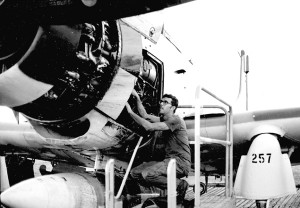I wrote this several years ago in hopes that it might prevent “going in with a load” syndrome. It has happened way too many times over the years. Walt and I have tried to figure out what part of the training is preventing crews from not “tossing the load” in an emergency. Maybe you can answer this question for us. Comments are more than welcome.
The last thing I remember was……
The season was almost over, it being late August, and some time off was sounding real good. It had been a busy season with over 248 hours flown on fires already. The DC-4 had preformed well the past five months. Aside from the usual fouled spark plugs, wore out boost pump and worn tires, no major problems have appeared.
The day was the last in rotation, tomorrow would be a day off to get caught up on laundry, paper work and a bit of fishing on the river. The base lead plane was filling in on a fire south of here, for a lead that timed out. They would be back at dark to be in position for any activity tomorrow. Having two tankers and a lead plane on the base reduces the stress load on the dispatches when one tanker has a day off.
About 5:45 PM the order was received for a load of retardant on a new fire just over the mountain to the northwest of here. It was a new start and not much information was available from the spotter plane. The decision to Initial Attack the fire was passed down and a load of smokejumpers requested. The tanker was loaded and we taxied for takeoff. Just before reaching the runway the co-pilot nudged me and pointed to the map. He had marked the coordinates dispatch had given us. The circle mark was in a narrow valley two ridges out. I knew the area and felt it would not present a problem for us to get a load on it. I gave him the thumbs up and a grin to set him at ease. It was his first season as a tanker co-pilot, a soon to be father and he was a bit unsure about his choice in profession.
After takeoff we called dispatch and gave them our time to the fire and got the frequencies for the spotter and incoming smokejumpers. The air was clear and smooth, perfect day for fighting fire. We could see the smoke, just a small column, after gaining a bit of altitude and headed straight for it. As we circled over the fire I called for the drop check list and the co-pilot started through the dozen or so items. I called dispatch and reported over the fire, gave them a description of the fire and told them I was ready to drop. They replied the air was mine and the smokejumpers were expected to arrive in about one hour, due to mechanical problems with their jump ship. The spotter had to leave the area as we arrived due to low fuel. The nearest ground team was two hours away headed this direction, but access would be difficult due to the lack of roads. They requested that I call them after the drop with an ETA to the base. I responded, “Affirmative.” then flaps 10 over the intercom.
The co-pilot informed me that all the drop checks were complete and we were “hot” to go in for the drop. I ran through the plan I had for the drop and gave him the usual safety brief. As I descended lower to line up, I noticed the ridge on our escape to be a bit higher than I had first estimated. I was planning on a quick half/half drop as the fire was small and one load should hold it till the smokejumpers arrived.
As we turned down the valley for a long final to the drop, I scanned the instruments and called for flaps 20. Everything felt good and the gages looked normal. I pulled the power back a bit more till I could just hear the engines purring and called flaps 32. I could tell they deployed as it felt like an anchor had been dropped. We were short final and on line, on speed, on altitude and smile turned on. (God I love this job!!) Then “IT” happened. As my thumb moved to the drop button, number one engine barked, snorted, wheezed, banged, shook and puked. All faster than I could turn my head. I called for climb power, checked the gages and noticed number one’s RMP low and oil pressure dropping. I called number one engine out and pulled the throttle to verify that number one was the problem. I then pulled the mixture to number one and made the call to feather number one engine and secure it. I was trying to remember to fly the airplane first…deal with problem second. I called for flaps 20. As the co-pilot proceeded to secure number one I was looking for a way out. The narrow valley offered us nowhere to turn around. We were climbing very slowly, ok flaps 10 and go to best rate of climb speed, I thought. There must have been a light tail wind, acceleration was very slow, and I needed more speed and altitude to get over the ridge ahead. I made the call to open the cowl flaps a bit to cool the engines. We didn’t need to loose another engine, but neither did I need the drag caused by them.
Suddenly the knot in my stomach tightened and I realized we could not get over the ridge. I started to call “max power” but knew it would not help and might cause loosing another engine. I looked for a clear spot ahead but only a canopy of trees ahead. The hillside was not very steep and might provide for a survivable crash. I tried to call dispatch but could not make contact so I made a blind transmission that we were going down 1 mile east of the fire. My co-pilot hearing this did not look very happy but he trusted my abilities and was ready to do what I needed him to do. I called for full flaps, picked a spot and reduced the power. As we settled above the treetops and began to slow as much as possible. I cut the throttles and mixtures, called for him to hit the gang bar, shutting off all power in the aircraft, and magnetos off to lessen the chance of fire.
It got real quiet for a second or two, then the brushing of tree tops on the under side of the aircraft. I though, for an instant, this isn’t too bad. Then there was the sound of wood tearing away at metal. The whole aircraft shook, bounced, cracked, groaned, and went into gyrations that threw us around the cockpit like rag dolls.
The last thing I remember is a little voice asking me, “Why didn’t you get rid of the retardant?”
This is a fictional story, but has happened to more than a few tankers over the years. Most of them were very experienced crews also. When there is a problem with the aircraft the retardant is forgotten and carried into the hillside with the plane. We are trained to be ready to get rid of a load on takeoff; there is a lot of mud left at the end of several runways! However, it seems we get pretty comfortable once airborne and have a bit of altitude to work with. I even know of one instance where an engine was lost on a tanker enroute to a fire. Only 1/3 of the load was dropped to reach the landing weight for the aircraft before it landed. Later the plane had to be fully unloaded to allow the engine change because the tail jack would not support its weight. The pilot thought he made a good decision in saving the retardant. I suppose he did not think of a possible go-around or problems with another engine. Is there enough and quality training in you program on emergency drops? Do you feel comfortable getting rid of the load in an emergency situation. How long do you think you would wait till you got rid of the load in an emergency? You have a perfect situation where you can get rid of the weight if you choose. It is not like throwing the passengers out or kicking freight, but it is seldom thought of. I would like anyone’s opinion as to why this happens.
As part of the safety committee, I am trying to find a few answers. In the meantime, make a serious effort to talk about this with others pilots and send me your thoughts as to why and how to prevent this from happening.
Safety is planned…not accidental,
ODiM
odimdc3@gmail.com












These are the questions that intrigue me. How do we change the behavior of pilots…why do we need to change the behavior of pilots, when the behavior seems so elementary?
I think one of the root causes to this lies with the lack of training and knowledge of effective task prioritizing…particularly with regards to abnormal and dynamic situations, and prioritizing within a team. I also think some of these priorities (i.e jettisoning the load) should become a conditioned response to certain circumstances. We’re taught from the first entry in our logbook that you fly the airplane above all other things. We’re just not trained effectively, that pitching the load is inclusive to this priority.
Chuck nails it; dropping the load IMMEDIATELY needs to be “muscle mantra”. If you don’t do it automatically, you can easily get distracted with fixing the aircraft malfunction first. It makes me puke to think of all the friends that have gone in with the load still on board.
CFPA instructors go through this every year with every pilot in every imaginable situation and phase of flight. Its amazing how easy it is to forget JETTISON as the #1 item on the emergency, and sometimes abnormal, checklist after a few months out of the cockpit. Or at the end of a long season, many months since refresher training, happy and content and comfortable in your “office”. The tendency is to immediately focus on fixing the malfunction, as in Chuck’s story. So they practice and practice and practice until its an automatic response.
It was one of the few things you could count on getting a comment on from Ralph Ponti; “Its only a load of mud”.